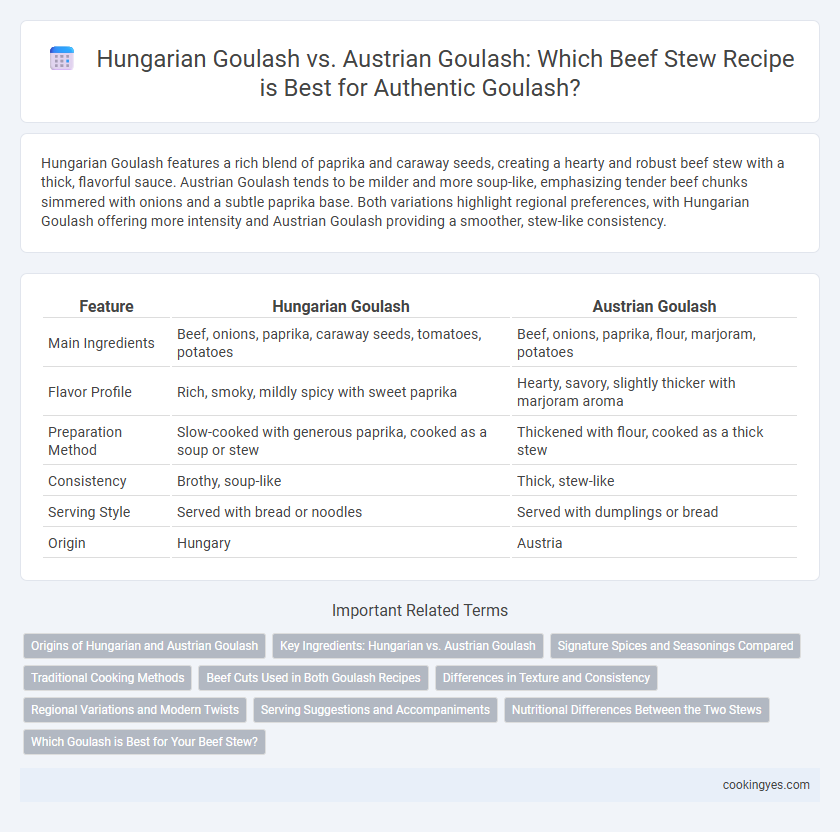Hungarian Goulash features a rich blend of paprika and caraway seeds, creating a hearty and robust beef stew with a thick, flavorful sauce. Austrian Goulash tends to be milder and more soup-like, emphasizing tender beef chunks simmered with onions and a subtle paprika base. Both variations highlight regional preferences, with Hungarian Goulash offering more intensity and Austrian Goulash providing a smoother, stew-like consistency.
Table of Comparison
| Feature | Hungarian Goulash | Austrian Goulash |
|---|---|---|
| Main Ingredients | Beef, onions, paprika, caraway seeds, tomatoes, potatoes | Beef, onions, paprika, flour, marjoram, potatoes |
| Flavor Profile | Rich, smoky, mildly spicy with sweet paprika | Hearty, savory, slightly thicker with marjoram aroma |
| Preparation Method | Slow-cooked with generous paprika, cooked as a soup or stew | Thickened with flour, cooked as a thick stew |
| Consistency | Brothy, soup-like | Thick, stew-like |
| Serving Style | Served with bread or noodles | Served with dumplings or bread |
| Origin | Hungary | Austria |
Origins of Hungarian and Austrian Goulash
Hungarian Goulash originates from the traditional shepherds' stew of Hungary, characterized by its rich use of paprika and caraway seeds, reflecting the country's culinary heritage. Austrian Goulash, influenced by Hungarian cuisine through the Austro-Hungarian Empire, typically features a thicker sauce and a milder paprika flavor, adapting the dish to Austrian taste preferences. Both variations highlight regional differences in spice blends, cooking techniques, and historical cultural exchanges that have shaped their distinct flavors.
Key Ingredients: Hungarian vs. Austrian Goulash
Hungarian Goulash features key ingredients such as tender beef, smoked paprika, onions, caraway seeds, and tomatoes, creating a rich and spicy stew with a thick, hearty sauce. Austrian Goulash, in contrast, uses lean beef, sweet paprika, onions, garlic, and a broth-based sauce with a lighter consistency, often served with bread or dumplings. The distinct paprika varieties and seasoning differences define the authentic flavor profiles between Hungarian and Austrian versions of beef goulash.
Signature Spices and Seasonings Compared
Hungarian goulash features a rich blend of ground paprika, caraway seeds, and garlic, creating a deeply aromatic and slightly smoky flavor profile essential to its traditional beef stew. Austrian goulash, while also using paprika, tends to incorporate marjoram and bay leaves, resulting in a milder, herbaceous seasoning that balances the paprika's warmth. The contrasting use of caraway in Hungarian versus marjoram in Austrian recipes highlights the distinct regional approaches to seasoning this classic beef stew.
Traditional Cooking Methods
Hungarian Goulash uses a slow-cooking method that involves simmering beef in a rich broth of paprika, onions, and caraway seeds, enhancing the deep, smoky flavors characteristic of traditional Hungarian cuisine. Austrian Goulash often incorporates sauteed onions and beef stew meat cooked until tender with a thicker, gravy-like sauce enriched by paprika and sometimes flour, reflecting a creamier texture preferred in Austrian kitchens. Both styles emphasize low and slow heat to tenderize the beef, but Hungarian Goulash retains a soupier consistency while Austrian Goulash tends to be more stew-like.
Beef Cuts Used in Both Goulash Recipes
Hungarian goulash traditionally uses beef shank or chuck, which provides rich marbling and connective tissue ideal for slow cooking, resulting in tender, flavorful meat. Austrian goulash often favors beef shoulder or shin cuts that maintain their structure during simmering, offering a firmer texture while still absorbing the paprika-spiced broth. Both variations prioritize cuts with sufficient collagen to achieve a hearty, tender stew, essential for their distinctive regional taste profiles.
Differences in Texture and Consistency
Hungarian goulash features a thicker, stew-like consistency with tender, slow-cooked beef chunks immersed in a rich, paprika-spiced sauce, creating a hearty and somewhat rustic texture. Austrian goulash tends to have a thinner, soup-like broth with finely chopped meat and vegetables, resulting in a lighter and smoother consistency. The texture difference stems from Hungarian goulash's longer cooking time and use of flour or thickening agents, versus Austrian goulash's more broth-focused preparation.
Regional Variations and Modern Twists
Hungarian Goulash traditionally uses a rich paprika-based sauce with beef, onions, and caraway seeds, emphasizing a hearty, slow-cooked stew that highlights regional spices. Austrian Goulash tends to be thicker and sweeter, often incorporating marjoram and sometimes a touch of vinegar or tomatoes, reflecting Central European culinary influences. Modern twists on both versions include adding root vegetables or substituting beef with game meat, appealing to contemporary tastes while preserving authentic regional flavors.
Serving Suggestions and Accompaniments
Hungarian Goulash, traditionally served with thick slices of rustic bread or buttered spaetzle, emphasizes robust paprika flavors that pair well with tangy pickled vegetables and sour cream as a cooling accompaniment. Austrian Goulash tends to be milder and is commonly enjoyed alongside buttery potato dumplings or soft egg noodles, enhancing its rich, stew-like consistency. Both variations benefit from garnishes like fresh parsley to elevate the dish's presentation and balance the savory, hearty beef stew.
Nutritional Differences Between the Two Stews
Hungarian Goulash typically contains paprika, onions, and beef with a thicker, spicier broth, resulting in higher antioxidant content and increased vitamin A from the paprika. Austrian Goulash often uses less paprika and includes caraway seeds and marjoram, which contribute different phytonutrients and slightly lower calorie density due to a leaner beef cut. Both stews offer rich protein from beef, but Hungarian Goulash tends to have more fat and sodium, while Austrian Goulash provides a lighter yet aromatic nutrient profile.
Which Goulash is Best for Your Beef Stew?
Hungarian Goulash, known for its rich paprika spice and hearty beef stew base, offers a robust and aromatic flavor ideal for those seeking traditional depth and warmth. Austrian Goulash tends to be milder with a thicker sauce, incorporating onions and caraway seeds, making it a smoother, less spicy option. Choosing the best goulash for your beef stew depends on your preference for bold paprika intensity versus subtle, creamy texture in the finished dish.
Hungarian Goulash vs Austrian Goulash for beef stew Infographic

 cookingyes.com
cookingyes.com